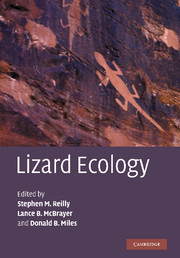Book contents
- Frontmatter
- Contents
- List of contributors
- Preface
- Historical introduction: on widely foraging for Kalahari lizards
- I Organismal patterns of variation with foraging mode
- 1 Movement patterns in lizards: measurement, modality, and behavioral correlates
- 2 Morphology, performance, and foraging mode
- 3 Physiological correlates of lizard foraging mode
- 4 Lizard energetics and the sit-and-wait vs. wide-foraging paradigm
- 5 Feeding ecology in the natural world
- 6 Why is intraspecific niche partitioning more common in snakes than in lizards?
- 7 Herbivory and foraging mode in lizards
- 8 Lizard chemical senses, chemosensory behavior, and foraging mode
- 9 Patterns of head shape variation in lizards: morphological correlates of foraging mode
- 10 Prey capture and prey processing behavior and the evolution of lingual and sensory characteristics: divergences and convergences in lizard feeding biology
- 11 The meaning and consequences of foraging mode in snakes
- II Environmental influences on foraging mode
- Index
- References
11 - The meaning and consequences of foraging mode in snakes
Published online by Cambridge University Press: 04 August 2010
- Frontmatter
- Contents
- List of contributors
- Preface
- Historical introduction: on widely foraging for Kalahari lizards
- I Organismal patterns of variation with foraging mode
- 1 Movement patterns in lizards: measurement, modality, and behavioral correlates
- 2 Morphology, performance, and foraging mode
- 3 Physiological correlates of lizard foraging mode
- 4 Lizard energetics and the sit-and-wait vs. wide-foraging paradigm
- 5 Feeding ecology in the natural world
- 6 Why is intraspecific niche partitioning more common in snakes than in lizards?
- 7 Herbivory and foraging mode in lizards
- 8 Lizard chemical senses, chemosensory behavior, and foraging mode
- 9 Patterns of head shape variation in lizards: morphological correlates of foraging mode
- 10 Prey capture and prey processing behavior and the evolution of lingual and sensory characteristics: divergences and convergences in lizard feeding biology
- 11 The meaning and consequences of foraging mode in snakes
- II Environmental influences on foraging mode
- Index
- References
Summary
Introduction
We examine current knowledge of the foraging modes of snakes with particular reference to the “syndrome hypothesis” (McLaughlin, 1989) as described for other organisms. Foraging modes of snakes are often flexible, with some species exhibiting both ambush and active tactics (Hailey and Davies, 1986; Duvall et al., 1990; Greene, 1997; see Table 11.1). In this chapter we focus on interspecific comparisons and broad-scale patterns among snakes; intraspecific variation in foraging mode is considered elsewhere (Shine and Wall, this volume, Chapter 6). In general, we find some evidence that snakes exhibit variation that is broadly consistent with the syndrome hypothesis. However, physiological and morphological data are scant, and phylogenetic relationships are poorly known. In addition, we question the criteria for defining foraging modes among snakes, and the dichotomous descriptive classification of snakes into “ambush” or “active” modes. We present evidence from bioenergetic simulation that suggests these dichotomous classes may be adaptive peaks; however, intermediate trait values are certainly attainable under permissive circumstances.
How are snakes different from lizards?
All snakes are carnivorous, gape-limited predators that swallow food whole. Therefore, snakes must supply energy to a relatively large body mass by ingesting potentially large prey through a relatively small mouth (Greene, 1997). The squamate reptile skull has evolved greatly from a relatively rigid (non-kinetic) form typical of lizards to a highly modified and highly kinetic form typical of the advanced snakes (alethinophidians, Fig. 11.1) (Greene, 1997; Cundall and Greene, 2000).
- Type
- Chapter
- Information
- Lizard Ecology , pp. 334 - 368Publisher: Cambridge University PressPrint publication year: 2007
References
- 15
- Cited by



